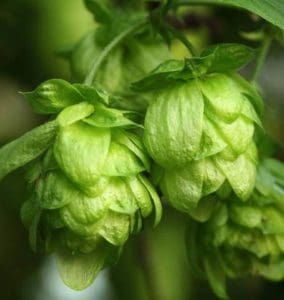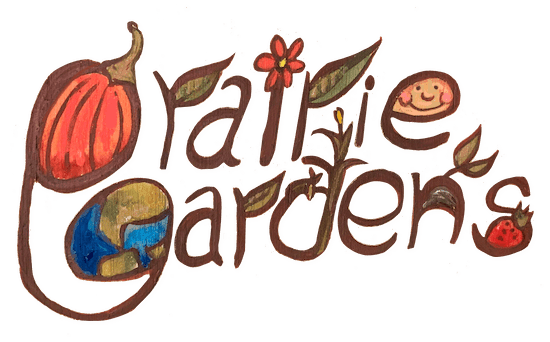Alberta has the perfect climate to grow Hops! You can grow your own Hops to make your own delicious beer! And they are beautiful vines in your garden! Highly decorative, fast growing, trouble free, and cold hardy, hops provide a dual purpose interest to gardens that few other plants do. Create a privacy screen, and use them to brew your own beer! They can climb as much as 20 feet in one season. They are a twiner, called a “bine”, whirling around trellis, poles, or wire supports. And no, bine is not a typo! A bine is any plant with a stem that twists around something as it grows. Hops are herbaceous perennials hardy to zone 3. Expect them to die back to the ground in the winter and to leap back to life in the spring.
Botanic name: Humulus lupulus Family: Cannabaceae
Difficulty: Easy
We Recommend these Varieties:
Cascade organic is a great all-purpose variety, and probably the most widely used in the brewing industry. This is an extremely versatile and flavourful variety that is typical in IPA recipes, pale ale recipes, and others. Cascade is the true workhorse of the craft brewing industry. Be sure to provide a tall trellis for all your hops plants, as they are vigorous climbers. Harvest the flowers or “cones” in late summer.
Aroma: Spiced floral with distinct but subtle undertones of citrus and grassy notes.
Flavour: The citrus flavour is higher than its aroma. Very smooth.
Brewer’s Gold organic hops is an old North American heirloom variety, developed in 1919 from an original open pollinated strain in Manitoba. This is the ancestor of many modern bittering types, and its both high yielding and vigorous. Be sure to refrigerate harvested hops in both the fresh and dried stages for the best shelf life. Provide stout support for this vigorous upright climber. Harvest the flowers or “cones” in late summer.
Aroma: Hints of black currant.
Flavour: Lightly spicy with piney undertones.
Centennial organic hops produce female flowers that are used as bittering agents in beer production. It is also a dual purpose hops variety that can be used as a general flavour enhancer. Centennial is commonly used in pale ales and many other beer recipes. It originated as a cross from Cascade with many of the same uses. Provide a tall, stable trellis, line, or pole for this vigorous climber.
Aroma: Floral, but not too strongly, with less notable citrus tones than Cascade.
Flavour: More bitter than Cascade, with citrus and spicy tones.
Chinook organic hops are usually planted to produce bittering hops. The cone-like female flowers develop high on long, very tall vines in late summer and are dried for use in craft beer making. Chinook has a very different aroma and flavouring quality than Willamette or Fuggles. Grow hops in full sun or partial shade, but be sure to provide ample vertical trellis for the tall vines to clamber up. Harvest and dry as you would any other variety.
Aroma: Spicy with smoky pine undertones.
Flavour: An earthy bitterness with a hint of spice (hotness).
Fuggles organic hops is grown for the aroma of its strongly scented flowers. This aroma adds a whole new dimension to a wide assortment of beer recipes. Fuggles adds a mild, subdued, subtle note of lightly bitter, floral hoppiness and vegetative smokiness that makes it perfect for use in craft brewing. Hops grows super-fast, and super tall before dying back at the end of the season. Be sure to provide an adequate trellis, or grow it straight up a long cable or pole. Flowers mature in late summer for drying and use in home beer making. Fuggles is a rare variety for the beer gourmet.
Aroma: Fuggles is herbal and spicy with only a distant hint of pine.
Flavour: Vegetative and woody, with some bitterness.
Goldings hops is most frequently used in dry hopping. Goldings organic hops offer a superior balance between aroma and taste without overpowering the first addition of bittering hops. Home beer brewers and craft beer makers will appreciate the ability to layer subtle hops flavours over one another. Goldings brings a deeper flavour out of the first application. Grow hops with very sturdy and tall supports or trellis. Growing up a cable or rope is a good option, as the tall vines are vigorous and will cover a fence or trellis in no time.
Aroma: Lavender and citrus.
Flavour: Very smooth combination of apricot, peach, and citrus.
Willamette organic hops rhizomes are planted to produce hops flowers used primarily for aroma. Willamette complements almost any style of beer because of its balanced aroma and flavour profile. Plants get tall, so be sure to provide ample support with trellis, lines, or poles, and look forward to harvesting and drying the female flowers near the end of summer. Grow as an ornamental screen along a fence or hedge.
Aroma: Spicy and herbal fruit scents. Willamette adds complexity to the aroma of a wide variety of brewed beverages.
Flavour: A very clean and even flavour profile with no trace of pine.
HOW TO GROW:
Season & Zone
Season: Warm season
Exposure: Full sun to partial shade
Zone: 3 and up
Timing
Plant hops in early spring, as soon as the risk of frost is low (mid to late May).
Growing
Ideal pH: 6.0-7.0. Be sure to train them to twine around a support when they are about 30cm tall (1’), as hops have been known to reach up to 7.5 meters in a year. Mulch with loose soil as it is important the rhizomes do not dry out while establishing themselves. Hops are heavy feeders that require nitrogen rich amendments. First year growth will be limited while the roots establish themselves but you can expect to harvest some cones in the first year, more in the second and a full harvest in the third.
If you are planting more than hop variety, space them at least 1m apart (3’); space different varieties 2m (6’) apart. There is little difference in the appearance of hop varieties. It will be much easier to keep track at harvest time when you are harvesting the cones to grow them some distance from each other. In the second year you can expect several bines to have developed. Cut back the weakest of them, leaving the strongest 2 or 3 to grow out.
Harvest
Hops are ready for harvest when they become light and papery to the touch and when the leaves of the cones start to turn yellow at the edges. The lupulin powder, that contains the essential oils, turns golden yellow and becomes quite fragrant. Spread the flowers out in a single layer on a screen and air dry for a couple days with a fan blowing across them. They are ready to store in the freezer in an airtight baggy when the cones barely break when bent in half.
Diseases & Pests
Watch for slug/snail damage to young seedlings. Keep the area free from debris where these pests like to nest.

